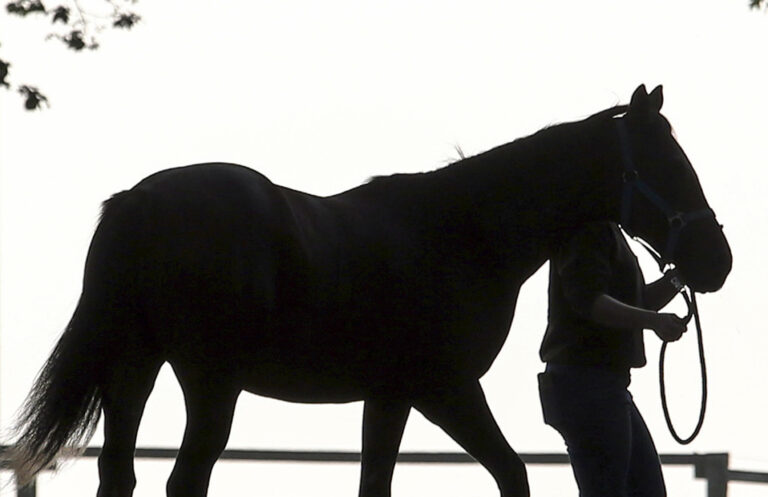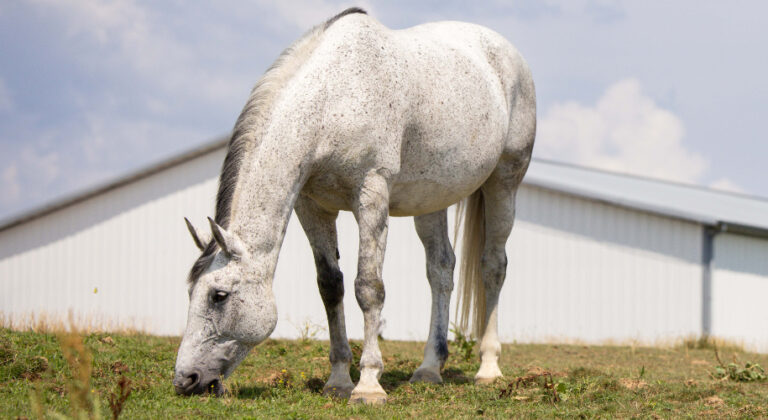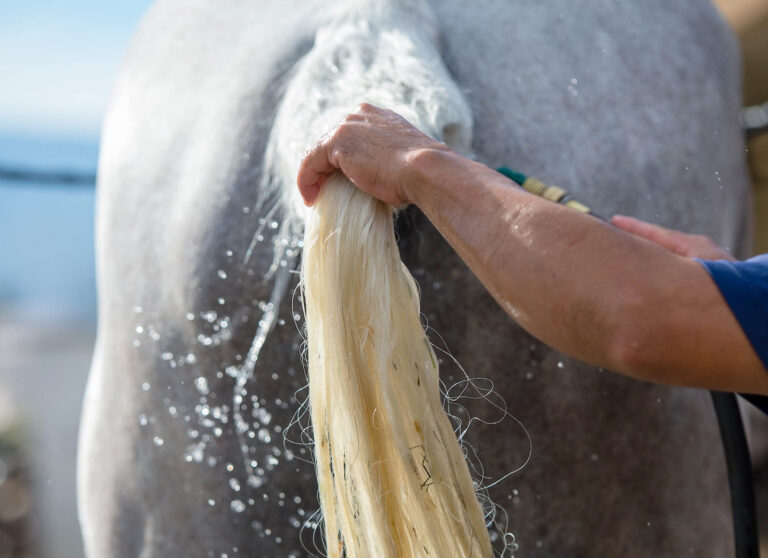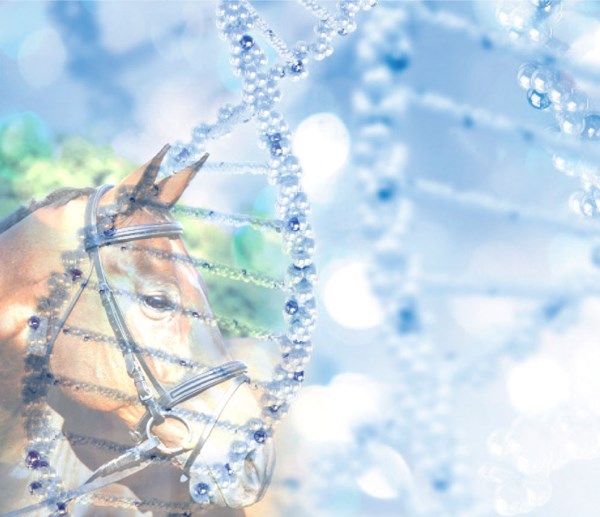
A thoroughbred event horse ties up after a distance workout. A Welsh Pony suffers a crippling episode of laminitis. A young warmblood in training for dressage develops sore hocks. Different horses, different breeds, different circumstances and different problems, but in each case, heredity may be partly to blame for the trouble.
Genes, the coded instructions within body cells, control how every living creature appears and how it functions. Genes help determine whether a horse excels as an athlete or falls prey to certain diseases. Now scientists are deciphering the genetic code, and their work could lead to major breakthroughs in horse health. Researchers are investigating the role of genes in diseases ranging from moon blindness in Appaloosas to melanomas in gray horses.
Here, Molly McCue, DVM, MS, PhD, an associate professor at the University of Minnesota College of Veterinary Medicine and a leading researcher in the field of equine genetics, explains what’s being learned about the role of genes in five conditions that are common in sporthorse breeds and that affect muscle, metabolism and bone. Your horse’s genes won’t necessarily dictate his destiny, she says, but knowing about them may help you take better care of him.
Breeds, Genes and Health
Modern horse breeds are nothing like the wild horses of prehistory. Over centuries, selective breeding has concentrated genes that influence performance traits like strength and speed, as well as conformation and color. But as breeders have focused on desirable traits, they’ve inadvertently concentrated some genes that may increase a horse’s risk of disease or unsoundness.
Science is just beginning to untangle these links. Aided by computers, Dr. McCue and other researchers are able to quickly read (or sequence) large numbers of DNA samples. They are using that ability to locate disease-related genes with a technique called genome-wide association.
The method involves analyzing DNA from hundreds or thousands of horses, some diagnosed with the condition being investigated and some unaffected. The researchers hunt for genetic markers, DNA sequences with known locations. Markers near a disease gene are shared much more frequently by affected horses than by unaffected horses, and those markers are used to map the location of disease genes. Once the researchers know which small area of a chromosome has a disease gene, they can select specific genes to sequence to find the exact variations that are responsible.
“There are simple genetic traits, like gray coat color. If a horse has the gray mutation, he will gray with age,” Dr. McCue says. In these cases whether a horse has a certain gene determines whether he develops the corresponding condition. Hyperkalemic periodic paralysis, a disorder that affects certain Quarter Horses, is an example. HYPP affects the complicated chemical/electrical events involved in muscle contraction. Horses that have it can suffer uncontrolled muscle contractions, weakness and even paralysis or respiratory failure. It has been traced to a single genetic mutation passed on by Impressive, a leading Quarter Horse sire with many descendants, and horses that trace to Impressive can be screened for the defective gene. Those that have it will develop HYPP, although the condition varies in severity and can often be managed with changes in diet and exercise.
For most breed-related conditions, though, the picture is more complex. “More than one gene may be involved, and the influence of the environment is important,” Dr. McCue says. That’s the case with the disorders covered here.
Muscle Trouble
Muscle stiffness and spasms, sweating, rapid breathing and reluctance to move are signs of tying up, which can cause damage to muscle. Horses with the muscle disorder known as polysaccharide storage myopathy (PSSM, also called equine polysaccharide storage myopathy or EPSM) may tie up after even light work.
What happens: Muscles need energy to work and they keep a supply in the form of glycogen, a complex sugar they break down when need arises. In PSSM excess glycogen builds up in muscle fibers. Some of the excess is stored in the form of an abnormal complex sugar, a key feature of the disease that can be discovered with a muscle biopsy. The condition is like a metabolic monkey wrench, interfering with the ability of the muscle to function.

Diet and management have a big role in this condition. Most PSSM horses stop showing signs when they’re switched to high-fat and -fiber, low-starch rations, but they still remain susceptible.
Who’s at risk: PSSM occurs mostly in Quarter Horses and related breeds, draft breeds and crosses and warmbloods. It seems to be slightly different in different breeds:
• Quarter Horses typically have classic signs of tying up.
• Draft horses often show muscle weakness and atrophy or have difficulty backing and picking up hind feet.
• Warmbloods often develop sore muscles and may show reluctance to collect.
The types of work these horses do may partly account for the signs, but it appears that different genetic factors are involved.
What’s known: Researchers have identified a genetic mutation that causes one form of the condition, PSSM Type 1. The mutation is dominant, meaning that a horse who gets a copy of the gene from either parent can develop the condition. A test for the gene is available through the University of Minnesota Veterinary Diagnostic Laboratory.

However, not all horses with the condition have this mutation. “We think that about 20 percent of Quarter Horses with PSSM as diagnosed by muscle biopsy have a different form, Type 2,” says Dr. McCue. “We think that about 80 percent of warmbloods with PSSM based on muscle biopsy have something other than Type 1. We call that Type 2, but whether it is the same as what the Quarter Horses have, we don’t yet know.”
What’s next: Dr. McCue’s lab has been hunting for a PSSM Type 2 gene. “We think we have identified the region where it exists, but we don’t have the gene yet,” she says. More forms of the disease may surface, she adds. “There are many glycogen-storage muscle disorders in other species—including more than a dozen in humans—so it’s possible that horses get more of these disorders than have been identified so far.”
More Muscle Trouble
Any horse may tie up if he’s exercised harder than his level of conditioning allows—when his workload is abruptly increased, for example, or he returns to work after time off. This form of tying up is called exertional rhabdomyolysis, and some horses are more susceptible. Horses that tie up repeatedly are said to have recurrent exertional rhabdomyolysis.
What happens: RER often appears as horses move up in training. Typically these horses tie up with sustained exercise (for example, a distance workout at a moderate pace). Some research suggests RER involves a problem with the way calcium, which plays a vital role in muscle contraction, is regulated inside the muscle cells.
Who’s at risk: While any horse can suffer an incident of tying up in the right conditions, Thoroughbreds, Standardbreds, racing Quarter Horses and Arabians are the breeds most often affected by RER. The condition has been reported in 5 to 7 percent of Thoroughbreds and Standardbreds.
What’s known: Researchers at the University of Minnesota have been studying RER in Thoroughbreds and Standardbreds. “They show similar signs, but the precise mechanisms may be different,” Dr. McCue says. The condition seems to be moderately heritable in both breeds. “A good portion of the risk is genetic, but other factors determine whether the individual develops the problem,” she says. Besides work level, triggers include a nervous temperament and stressful conditions. Fillies are more likely than colts to develop the disorder. Diet—especially large amounts of grain or sweet feed—also seems to be a factor. Signs often improve with changes in exercise, diet and management.
What’s next: Researchers are working to identify the genetic risks for tying up. They hope to locate the gene or genes that result in altered muscle contraction, along with other genetic factors that may affect muscle development and function.
Susceptibility to tying up is not a simple genetic trait, Dr. McCue notes. “This truly is a complex genetic disease. The causes are environmental and genetic combined—if you manipulate the environment, you affect the outcome. These complex genetic conditions are where research is heading.“
Shivers
Shivers is a neuromuscular disease in which muscles in the hindquarters undergo periodic spasms.
What happens: Signs often appear when a handler tries to back the horse. The muscles in the pelvis and thigh may tense or tremble, and the horse may hold a hind leg flexed and trembling. He may jerk his tail upward or hold it aloft. The signs are intermittent, so it can be hard to diagnose. The cause is unknown.
Who’s at risk: Shivers mainly affects draft breeds but has also been reported in warmbloods, warmblood-crosses and some light breeds.
What’s known: A genetic connection seems likely—shivers has been seen for centuries, and old reports suggest that careful breeding could prevent it. So far no specific genetic pattern has been identified, though, and there is no genetic test.
Because some breeds are prone to both shivers and PSSM, the two conditions were once thought to share common genetic roots. But a University of Minnesota study of Belgian draft horses found no direct relationship between PSSM and shivers, Dr. McCue says, so the association is probably a coincidence.
What’s next: “We need a better understanding of shivers before we can find a genetic cause,” Dr. McCue says. Difficulties in finding cases and accurately diagnosing the disease complicate the work. As a starting point, researchers have studied videos of horses with reported shivers in an effort to better define its characteristics. Dr. Stephanie Valberg, of the University of Minnesota’s Neuromuscular Diagnostic Laboratory, and Dr. John Baird, of the Ontario Veterinary College, are among the scientists involved in this effort.
Metabolic Syndrome
Three features characterize equine metabolic syndrome:
• Insulin resistance, a metabolic problem that makes it hard for a horse to process carbohydrates
• Obesity (or regional fat deposits, like a cresty neck)
• High risk of laminitis, a devastating foot disorder in which the bond between the hoof wall and the underlying bone weakens or gives way.
EMS shares those signs with equine Cushing’s disease (pituitary pars intermedia dysfunction), a different condition that mainly affects horses over age 15, but EMS appears at a younger age.

What happens: Digestion breaks down carbohydrates in grain and forage into glucose, a simple sugar, that is absorbed into the horse’s bloodstream. The rising blood-sugar level signals his body to produce insulin, a hormone that allows body cells to take in glucose and convert it to energy. In insulin resistance the cells don’t use insulin properly, so the horse must produce more insulin to move glucose into cells. The problem is similar to Type 2 diabetes in humans (except that horses don’t typically develop high blood glucose as diabetics do). A horse with insulin resistance needs a special diet with limited starch and sugar to avoid overwhelming his system and triggering an attack of laminitis.
Who’s at risk: EMS is common in Welsh and other ponies, Morgans, Arabians, Andalusians and a few other breeds. It occurs less often in Thoroughbreds and Quarter Horses. Within the breeds, some horses seem more susceptible.
What’s known: “Great efforts are being made to understand EMS,” Dr. McCue says. Environment plays a big role in this disorder. If a horse is overfed and overweight, for example, he’s much more likely to develop signs. But, Dr. McCue says, “It’s not just that horses are fed too much—there are clearly underlying genetic factors.” When horses are managed under the same conditions, some develop the disorder and some don’t, she notes, and a chubby horse with EMS can lose weight but still have the metabolic problem.
Dr. McCue’s research team has gathered data on 600 EMS horses of various breeds, comparing glucose and insulin blood levels, body fat and other variables. The results are awaiting publication. Meanwhile, the researchers are hunting for genetic factors that may make horses susceptible to EMS. Dr. McCue suspects that multiple genetic factors contribute. Some are probably important across breeds, while others may be important only in some breeds. There may be genetic factors that protect horses against the condition, too.
What’s next: “We are looking first within the Morgan breed to find out what genetic factors affect the condition in those horses,” Dr. McCue says. Her team has identified key regions of the genome and is looking for specific variations, or alleles, associated with EMS. The team has also collected samples from 300 Welsh Ponies and plans to do the same with them.
“Being able to identify these alleles will allow us to assess risks in horses of different breeds,” Dr. McCue says. For example, it may be that Welsh Ponies are prone to EMS if they have a certain allele that affects fat metabolism, while different alleles may be more important in Morgans. Also, she says, “The effects of different alleles may add up to determine the risk for an individual horse. A horse may have only one or two of these alleles and so be at less risk than an individual who has more of them.”
Joint Defects
Osteochondrosis involves defects in the way bones develop at joints. The defects can appear in any of the leg joints, but the hock, stifle and shoulder are common sites. Although the defects typically form in the first year of life, signs often don’t appear until the horse begins training. Then, as he puts extra loads on his bones and joints, he comes up lame.
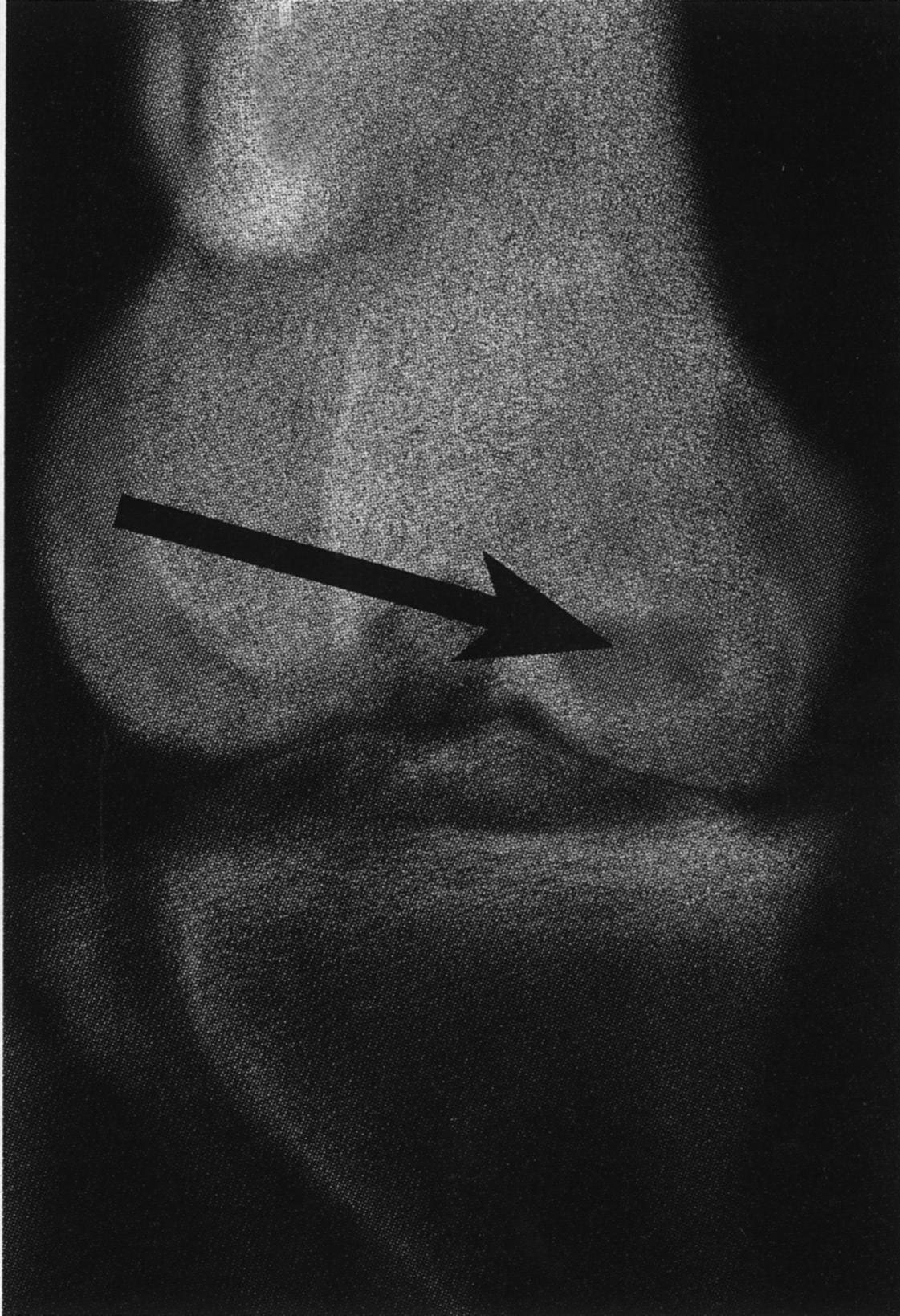
What happens: In young horses, growth cartilage at the joints gradually mineralizes, hardening into bone and leaving just a thin cartilage layer at the working surfaces of the joint. In osteochondrosis the process is incomplete. The cartilage may thicken and tear, a bit of cartilage or bone may pull away, or a fluid-filled pocket (a subchondral bone cyst) may develop in the bone under the cartilage.
Who’s at risk: Standardbreds, warmbloods, Thoroughbreds, Quarter Horses, Paints and European drafts have the greatest risk. Osteochondrosis is also more common in certain bloodlines within breeds.
What’s known: Many factors—nutrition, growth rate, exercise levels, conformation, injury—affect osteochondrosis. Genes are clearly involved, but it’s unlikely that the risk will be traced to a single gene. Instead, Dr. McCue says, the genetic picture may be similar to that of EMS—various alleles, some more important in certain breeds and bloodlines than others, interacting in ways that compound risks.
Ongoing studies in the United States and Europe are looking at the genetic risks for osteochondrosis in different breeds and different joint surfaces. University of Minnesota researchers have been concentrating on hock osteochondrosis in American Standardbreds. “We’ve found some likely genetic loci and identified some potential mutations that may be associated with the disease,” Dr. McCue says. Annette McCoy, DVM, PhD, spearheaded the Standardbred research at Minnesota and will continue her work in her current post at the University of Illinois.
What’s next: “The next step will be to test our findings in an independent population of European Standardbreds, to see if the association is still present,” Dr. McCue says. “We also hope to bring together the many research projects on osteochondrosis in a wider collaboration.” If the researchers can come up with a set of specific genetic variations that contributes to the disease, they’ll be able to apply the findings to assess the risk faced by any individual horse.
Long-Range Goals
The goal of genetic research isn’t to condemn horses that carry genes linked to health problems, Dr. McCue says. Instead, genetic information provides information on risks.
“Armed with that information, you can make smart decisions and manage horses better to reduce the risk,” she says. “If a foal is at risk for osteochondrosis, you can adjust his nutrition and grow him slowly to limit the risk. If a horse is at risk for EMS, you can monitor his diet and take him off pasture in spring. If a mare has an allele for a complex genetic disease, that doesn’t necessarily mean you can’t breed her. It just affects your choice of a mate; you breed to a horse that doesn’t share the same risk factor.
“This is where we’re headed with this research—finding a way to improve horses’ welfare,” she says. “We hope the horse-owning public will embrace this goal and not be fearful of the outcomes.”
Sidebar: Eight Things to Know About Your Horse’s Genes
1. Your horse has about 20,000 genes, arranged in 32 chromosomes inside the nucleus of nearly every cell in his body.
2. The chromosomes are basically long molecules of DNA (deoxyribonucleic acid). DNA molecules form twisting, paired strands, a pattern often referred to as a double helix. They are made up of chemical units called nucleotide bases, which act as a sort of genetic alphabet.
3. Each gene is a segment of DNA. The order of the nucleotide bases in the gene provides a set of coded instructions for making specific proteins that are used to build body tissues and carry out body functions.
4. A horse gets one copy of each chromosome from his sire and one from his dam, so he has two copies of every gene. The copies will be found in the same place (locus) on the paired chromosomes.
5. Sometimes a “spelling error” occurs in the code, resulting in a variation, called a mutation.
6. Minor differences in the code produce variant versions, or alleles, of genes. Variations can affect visible traits like coat color, but more often their effects aren’t so easy to spot.
7. If a foal gets different alleles of a gene from his sire and dam, he’s heterozygous for that gene. If both alleles are the same, he’s homozygous for that gene.
8. When a horse is heterozygous for a given gene, one of the two alleles will control the gene’s function. That allele is dominant and the other is recessive. Gray coat color is an example of a trait controlled by a dominant allele.
This article originally appeared in the March 2015 issue of Practical Horseman.





